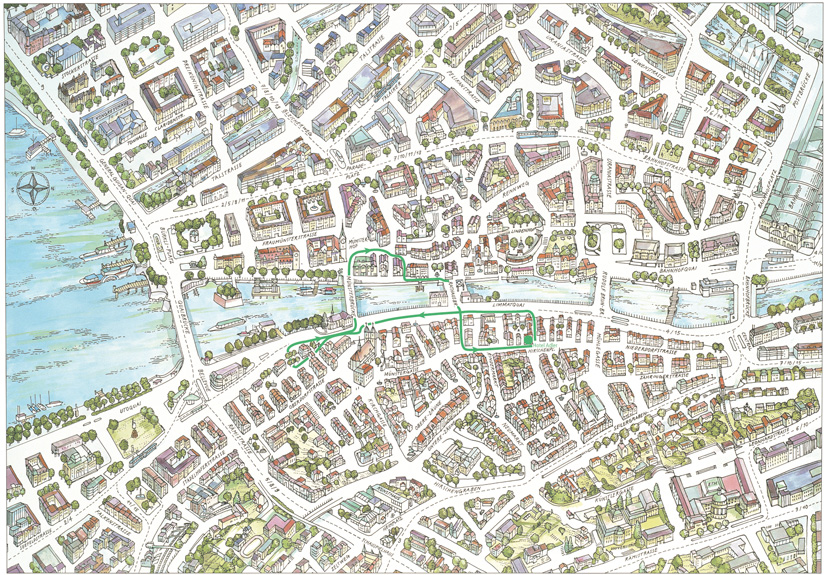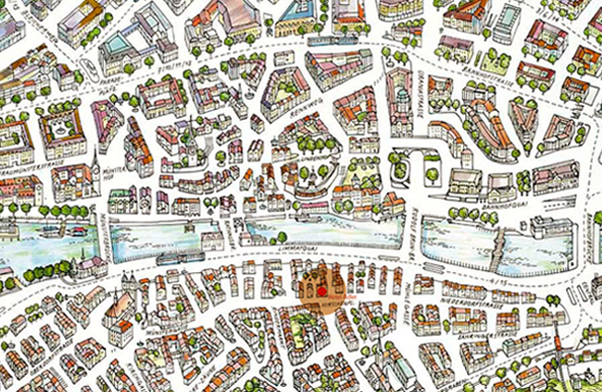Tour 3
Hirschenplatz – Rosengasse – Limmatquai – Rathaus – Rathausbrücke –
Rüden – Helmhaus – Schifflände – Münsterbrücke – Münsterhof – Storchengasse – Wühre – Weinplatz – Rathausbrücke – Rathaus – Marktgasse – Hirschenplatz
Map City Tour 3
Details: Tour 3
The imposing river embankment called Limmatquai was not built until the19th century. Originally, the houses on the right bank of the Limmat stood at the edge of the water. A narrow river-path, partly lying under arcades, provided access from the river to certain parts of the Old Town. Between 1823 and 1825, the first section of the Limmatquai was constructed and extended from Rosengasse to the Rathausbrücke. The continuous link between Bellevue and Central, involving further landfill, was built in stages during the following decades. At the same time, numerous houses along the Limmatquai underwent restoration or even complete rebuilding. On the way towards the Rathausbrücke, two buildings merit special attention, since they recall the architecture of the 1860s: the house of the “Museumsgesellschaft“ (Museum Society) at Limmatquai no. 62, which replaced the slaughterhouse, and the aristocratic “Haus zum Schneggen,“ at Limmatquai no. 64–66.
Zurich was considered “a river town“ until the 1880s, when the lakeside area was developed. The town centre used to be by the Rathausbrücke, also called Gemüsebrücke, which actually functioned both as a bridge and square. Until 1838, when the Münsterbrücke was built, the Rathausbrücke was the only bridge that allowed passage to vehicles and so constituted the main traffic artery between the two parts of town on either side of the Limmat. On the bridge, a fruit and vegetable market was held until well into the 20th century, hence the name Gemüsebrücke (vegetable bridge). Several other markets existed in the area around the bridge: Between the Rathaus and Rüdenplatz, under the arcades, was the fish market and a little downstream, next to the police station (built in 1825; Limmatquai no. 61), stood the well-proportioned “Fleischhalle“ (meat hall). In 1962, the meat hall fell victim to the widening of Limmatquai, much to the regret of many enthusiasts of architecture.
The Rathaus (Town Hall), situated at Limmatquai no. 55, has stood in the centre of the Old Town since the Middle Ages. The present Rathaus was built between 1694 and 1698, mainly in the Baroque style, although the facade shows a late Renaissance influence. On the facade, above the ground floor windows, numerous busts of public figures from Antiquity and from Swiss history can be admired, as can carved stone decorations representing garlands of fruit. Zurich’s city council and cantonal parliament hold regular sessions in the Rathaus, and citizens may follow the proceeding from the gallery. Visitors are also welcome to attend. The cantonal council meets on Mondays and the municipal council on Wednesdays.
Historic guild houses
From the Middle Ages on, the guilds established themselves in the immediate neighbourhood of the town hall, which explains the considerable number of guild houses in the area. Opposite the town hall, between the Rathausbrücke and Münsterbrücke, stand the guild houses “zur Zimmerleuten“ (Limmatquai no. 40), “zum Rüden“ (Limmatquai no. 42) and “zur Saffran“ (Limmatquai no. 54). The “Haus zur Haue“ (Limmatquai 52) is the home of the guild “zum Kämbel.“ All these guildhouses, dating back to a time when the guilds played an important role in the running of the town, merit special attention for their individual characteristics. The “Haus zum Rüden“ (Limmatquai no. 42) is chosen for closer examination because this particular guild house is depicted in one of the “Adler“ paintings. The first floor windows of the “Haus zum Rüden,“ in a striking Late Gothic style, are well preserved and provide a hint of what is hidden behind: a large Late Gothic room, the only one of its kind in Zurich, featuring an arched ceiling with decorative longitudinal wooden beams. The second floor is half-timbered and overhangs the lower part of the building.
Many of the guild houses have become excellent restaurants featuring a refined cuisine and hence they are open to the public. The festive atmosphere of the guild houses is especially enjoyable at wedding celebrations or banquets held in the splendid, historic rooms as well as during the “Sechseläuten,“ Zurich’s spring festival.
The guild houses, together with the other imposing buildings lining the right bank of the Limmat, provide an impressive view, to which the arcades add yet more charm. Before the construction of the Limmatquai, the arcades saw a bustle of activity, whereas today they function only as a pedestrian precinct. Above the row of houses standing between Rathaus and Helmhaus rise the two distinctive towers of the Grossmünster. For some people, the area around the Limmatquai represents the essence of a town that is proud of its history, traditions and architectural monuments. For others, this particular place, depicted in countless pictures, simply evokes a sense of belonging.
Helmhaus and Wasserkirche
The Helmhaus and the Wasserkirche (Water Church), which adjoin each other, used to stand on a small island in the Limmat. According to legend, Zurich’s patron saints, Felix and Regula, as well as their servant Exuperantius, were beheaded by the Romans on the site of the Wasserkirche.

The present Wasserkirche was constructed between 1479 and 1484 and is considered Zurich’s purest example of the Late Gothic style. The elegant church is surrounded by buttresses and has a polygon shaped choir. From the 17th century up to the construction of the Zentralbibliothek (see page 14), the Wasserkirche housed Zurich’s public library, which was established in 1629. To accommodate the library, Baroque galleries were built inside the nave of the church, and if they still existed, they would, without any doubt, constitute one of the city’s special places of interest. Often unnoticed, despite its large size, a monument to Zurich’s Reformer Huldrych Zwingli (1484– 1531) stands next to the Wasserkirche.

The Münsterbrücke
The Münsterbrücke (Minster Bridge) was built between 1836 and 1838 in order to replace the wooden “Obere Brücke.“ The bridge is the work of the Austrian building engineer Alois Negrelli (1799–1858), also known as Ritter (knight) von Moldelbe, who was one of the European pioneers of railway building. Among other projects, he built the first Swiss railway (see page 9) and was later involved in drawing up plans for the Suez Canal, which was built largely according to his ideas. The Münsterbrücke, with its four elegant arches and its cast-iron railings and candelabras, deserves to be admired since it is without doubt Zurich’s most beautiful bridge. In 1839, just after the bridge was built, Negrelli undertook the construction of the Grossmünster terrace and its Gothic parapet, as well as the small shops situated below the terrace.


The Weinplatz

The “Haus zum (roten) Schwert“ at Weinplatz no. 10 served as an inn from 1406 until 1918. After 1612, under the management of the Ott family, the house became the most famous inn of the town. The second part of the 19th century was the inn’s most notable period, when not only crowned heads and top military personnel but also poets and musicians stayed there. A rather discreet commemorative plaque on the left side of the front door lists some of the guests’ names, including Victor Hugo, Amadeus Mozart, Franz Liszt and Johannes Brahms.
Herzog (Duke) Karl August von Weimar, who, in 1779, stayed at the “Haus zum (roten) Schwert“ with Goethe (see page 39), was very impressed by the inn’s location and high quality: “Staying in the best inn, which stands by the bridge that holds the town together; having a charming view of the river, the lake and the mountains; enjoying wonderful meals, a comfortable bed and all the other things which usually come to pass in enchanted castles to gladden the hearts of knights.“
Reviews
Barry S
Google, 19.8.23
Very nice boutique Hotel. Convent to the main station and tram 4 . Maybe a ten minute walk . ( we walked upon arrival ) In a nice area of old town with many shops and restaurants steps away . Easy check in . They have complimentary water and drinks . Museum access that we took advantage of . Our room was on the top floor with a balcony . Would not consider staying anywhere else .
Sarah B
TripAdvisor, 19.8.2023
Nice location, even better people!
Anne Clarisse V
Google, 5.9.2023
Spent my birthday here and it was lovely. The fondue and raclette tasted amazing! And the staff was very friendly. They also sang happy birthday and brought out an ice cream dessert with a sparkler.
David S
TripAdvisor, 2.9.2023
Cheese fondue heaven.
Our Location
Hotel Adler Zürich
Rosengasse 10
CH-8001 Zurich
+41 44 266 96 96
info@hotel-adler.ch
Our front desk is available 24/7
Reviews
Our Partners
© Hotel Adler Zürich | Imprint | Terms & Conditions | Privacy | Voucher | Covid-19

















